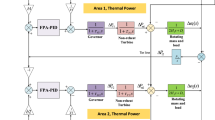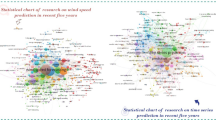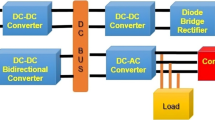Abstract
With the development of new energy, the primary frequency control (PFC) is becoming more and more important and complicated. To improve the reliability of the PFC, an evaluation method of primary frequency control ability (PFCA) was proposed. First, based on the coupling model of the coordinated control system (CCS) and digital electro-hydraulic control system (DEH), principle and control mode of the PFC were introduced in detail. The simulation results showed that the PFC of the CCS and DEH was the most effective control mode. Then, the analysis of the CCS model and variable condition revealed the internal relationship among main steam pressure, valve opening and power. In term of this, the radial basis function (RBF) neural network was established to estimate the PFCA. Because the simulation curves fit well with the actual curves, the accuracy of the coupling model was verified. On this basis, simulation data was produced by coupling model to verify the proposed evaluation method. The low predication error of main steam pressure, power and the PFCA indicated that the method was effective. In addition, the actual data obtained from historical operation data were used to estimate the PFCA accurately, which was the strongest evidence for this method.
Similar content being viewed by others
References
Ullah N.R., Thiringer T., Karlsson D., Temporary primary frequency control support by variable speed wind turbines—potential and applications. IEEE Transactions on Power Systems, 2008, 23(2): 601–612.
Erlich I, Wilch M., Primary frequency control by wind turbines. Power & Energy Society General Meeting. IEEE, 2010. DOI: https://doi.org/10.1109/PES.2010.5589911.
Miao Z., Fan L., Osborn D., et al., Wind farms with HVDC delivery in inertial response and primary frequency control. IEEE Transactions on Energy Conversion, 2010, 25(4): 1171–1178.
Morren J., De Haan S.W.H., Kling W.L., et al., Wind turbines emulating inertia and supporting primary frequency control. IEEE Transactions on Power Systems, 2006, 21(1): 433–434.
Weijia Y., Jiandong Y., Wencheng G., et al., Response time for primary frequency control of hydroelectric generating unit. International Journal of Electrical Power & Energy Systems, 2016, 74: 16–24.
Zhang G., Cheng Y., Lu N., et al., Research of hydroturbine governor supplementary control strategy for islanding AC grid at sending terminal of HVDC System. IEEE Transactions on Energy Conversion, 2016, 31(4): 1229–1238.
Molinagarcia A., Bouffard F., Kirschen D.S., Decentralized demand-side contribution to primary frequency control. IEEE Transactions on Power Systems, 2011, 26(1): 411–419.
Liu H., Hu Z., Song Y., et al., Decentralized Vehicle-to-Grid control for primary frequency regulation considering charging demands. IEEE Transactions on Power Systems, 2013, 28(3): 3480–3489.
Liao J., Luo Z., Yin F., et al., The analysis of UHV transmission’s impact on steam turbine operation. International Conference on ASME Power Conference Joint with Icope-17 Collocated with the ASME International Conference on Energy Sustainability, 2017. Paper No: POWER-ICOPE2017-3147, V002T11A002.
Wang W., Zeng D., Liu J., Niu Y., Cui C., Feasibility analysis of changing turbine load in power plants using continuous condenser pressure adjustment. Energy, 2014, 64(1): 533–540.
Zhou Y., Di W., An improved coordinated control technology for coal-fired boiler-turbine plant based on flexible steam extraction system. Applied Thermal Engineering, 2017, 125: 1047–1060.
Wang W., Li L., Long D., et al., Improved boiler-turbine coordinated control of 1000 MW power units by introducing condensate throttling. Journal of Process Control, 2017, 50: 11–18.
Huang H., Wu L., Han J., et al., A new synthesis method for unit coordinated control system in thermal power plant—ADRC control scheme. 2004 International Conference on Power System Technology, 2004. PowerCon 2004. DOI: https://doi.org/10.1109/ICPST.2004.1459980.
Liu J.Z., Yan S., Zeng D.L., et al., A new measurement model for main steam flow in power plants. Journal of Chinese Society of Power Engineering, 2011, 11(10): 18–24.
Leva A., Maffezzoni C., Benelli G., Validation of drum boiler models through complete dynamic tests. Control Engineering Practice, 1999, 7(1): 11–26.
Liu X., Lara-Rosano F., Chan C., Neuro-fuzzy network modelling and control of steam pressure in 300 MW steam-boiler system. Engineering Applications of Artificial Intelligence, 2003, 16(5–6): 431–440.
Daren Y., Zhiqiang X., Nonlinear coordinated control of drum boiler power unit based on feedback linearization. IEEE Transactions on Energy Conversion, 2005, 20(1): 204–210.
Han Z.X., Qi X.H., Li M., A practical non-linear mathematical model of generating unit and its application. Proceedings of the CSEE, 2006, 26(1): 58–65. (in Chinese)
Barsi D., Perrone A., Qu Y., et al., Compressor and turbine multidisciplinary design for highly efficient micro-gas turbine. Journal of Thermal Science, 2018, 27(3): 259–269.
Yue S., Wang Y., Wang H., Design and optimization of tandem arranged cascade in a transonic compressor. Journal of Thermal Science, 2018, 27(4): 349–358.
Tomar R.K., Kaushika N.D., Kaushik S.C., Artificial neural network based computational model for the prediction of direct solar radiation in Indian zone. Journal of Renewable & Sustainable Energy, 2012, 4(6): 289–625.
Ketabchi N., Naghibzadeh M., Adabi M., et al., Preparation and optimization of chitosan/polyethylene oxide nanofiber diameter using artificial neural networks. Neural Computing & Applications, 2016, 28(11): 3131–3143.
Naghibzadeh M., Adabi M., Rahmani H.R., et al., Evaluation of the effective forcespinning parameters controlling polyvinyl alcohol nanofibers diameter using artificial neural network. Advances in Polymer Technology, 2018, 37(6): 1608–1617.
Naghibzadeh M., Adabi M., Evaluation of effective electrospinning parameters controlling gelatin nanofibers diameter via modelling artificial neural networks. Fibers & Polymers, 2014, 15(4): 767–777.
Malekpour M.R., Naghibzadeh M., Najafabadi M.R.H., Esnaashari S.S., Adabi M., Mujokoro B., et al., Effect of various parameters on encapsulation efficiency of mPEG-PLGA nanoparticles: artificial neural network. Biointerface Research in Applied Chemistry, 2018, 8: 3267–3272.
Haykin S., Neural networks: A comprehensive foundation (3rd Edition). Prentice Hall, 1998.
Azami H., Mosavi M.R., Sanei S., Classification of GPS satellites using improved back propagation training algorithms. Wireless Personal Communications, 2013, 71(2): 789–803.
Fang Y., Fei J., Ma K., Model reference adaptive sliding mode control using RBF neural network for active power filter. International Journal of Electrical Power & Energy Systems, 2015, 73: 249–258.
Meng J.E., Wu S., Lu J., et al., Face recognition with radial basis function (RBF) neural networks. IEEE Transactions on Neural Networks, 2002, 13(3): 697–710.
Yun Z., Quan Z., Caixin S., et al., RBF neural network and ANFIS-Based short-term load forecasting approach in real-time price environment. IEEE Transactions on Power Systems, 2008, 23(3): 853–858.
Samadian H., Zakariaee S.S., Adabi M., Mobasheri H., Azami M., Faridi-Majidi R., Effective parameters on conductivity of mineralized carbon nanofibers: an investigation using artificial neural networks. RSC Advances, 2016, 6: 111908–111918.
Acknowledgment
This research was supported by the Electric Power Research Institute of State Grid Corporation of China in Zhejiang province.
Author information
Authors and Affiliations
Corresponding author
Rights and permissions
About this article
Cite this article
Liao, J., Luo, Z., Yin, F. et al. Primary Frequency Control Ability Evaluation of Valve Opening in Thermal Power Units Based on Artificial Neural Network. J. Therm. Sci. 29, 576–586 (2020). https://doi.org/10.1007/s11630-019-1203-8
Received:
Published:
Issue Date:
DOI: https://doi.org/10.1007/s11630-019-1203-8




